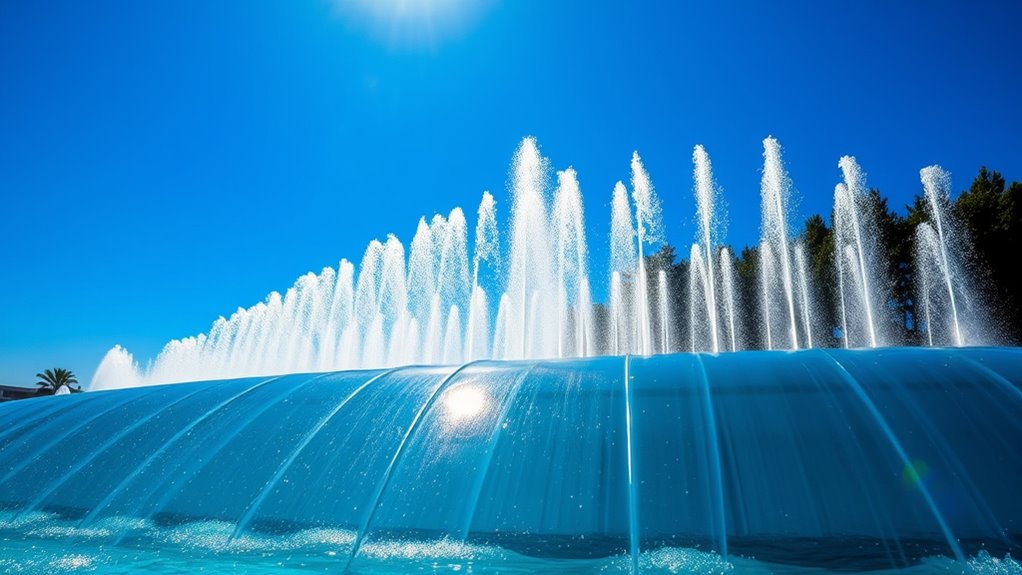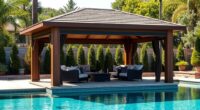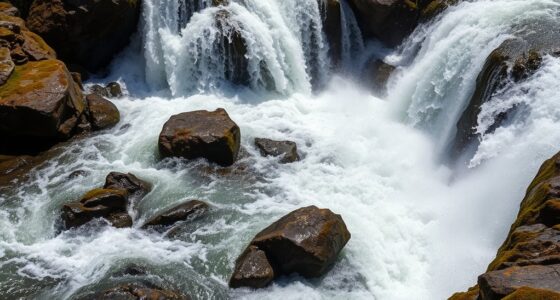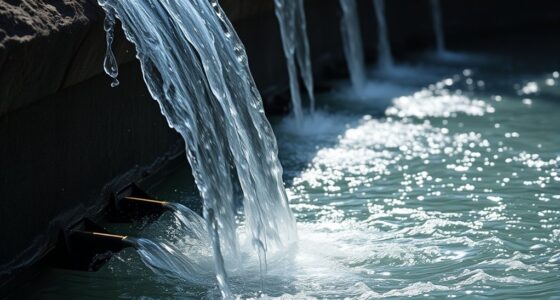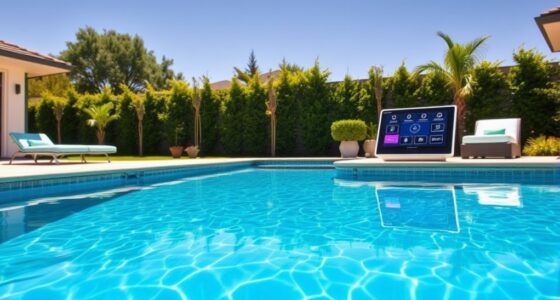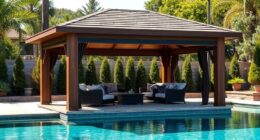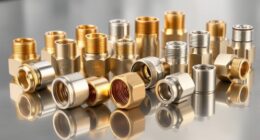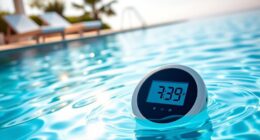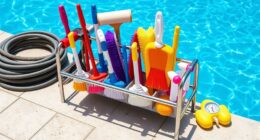Bubblers, deck jets, and laminar streams each create stunning visual effects, but they also impact water evaporation differently. Bubblers lose less water due to smaller surface areas, while deck jets and laminar streams tend to have higher evaporation rates. They also vary in energy use, with laminar streams generally consuming more. Balancing aesthetic appeal with conservation effort is key. If you want to explore ways to optimize both beauty and efficiency, you’ll find valuable insights ahead.
Key Takeaways
- Bubblers add lively, illuminated effects with minimal water loss due to smaller surface area.
- Deck jets create dramatic vertical streams that may increase evaporation and water consumption.
- Laminar streams offer sleek, modern aesthetics but typically have higher evaporation rates.
- Proper placement and design can balance visual impact with water conservation efforts.
- Energy-efficient operation and automated controls help minimize evaporation and environmental impact.
Visual Impact of Bubblers, Deck Jets, and Laminar Streams

The visual impact of bubblers, deck jets, and laminar streams considerably enhances a water feature’s overall aesthetic. Each element creates a dynamic focal point that draws attention and adds movement to your landscape. Bubblers produce playful, bubbling effects that can illuminate at night, creating a lively atmosphere. Deck jets shoot streams of water upward, offering a dramatic centerpiece or backdrop. Laminar streams provide sleek, smooth flows that appear almost glass-like, adding a modern, elegant touch. When positioned thoughtfully, these features complement your surroundings, emphasizing architectural lines or natural landscapes. Their varying heights, shapes, and water patterns allow you to customize the visual experience, making your water feature mesmerizing and unique. Additionally, selecting the right water feature technology can optimize performance and visual appeal, ensuring your installation remains captivating over time. Ultimately, they transform a simple water element into a striking visual statement.
Water Loss and Evaporation Rates of Different Features
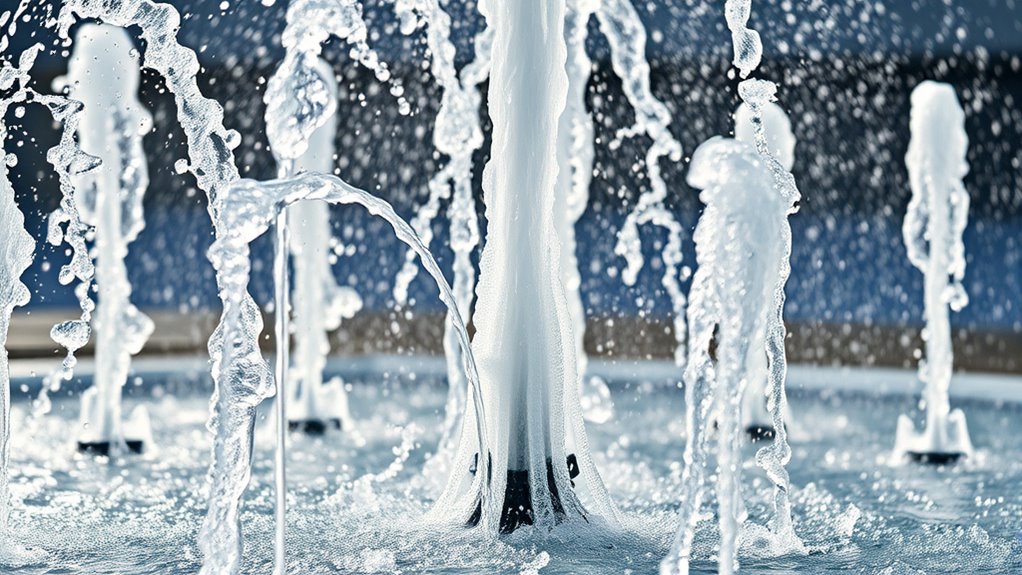
Understanding how much water features lose through evaporation and other forms of water loss is essential for proper maintenance and efficient operation. Different features have varying evaporation rates based on their design, size, and exposure to sun and wind. Bubblers typically lose less water due to their smaller surface area, while deck jets and laminar streams can evaporate more rapidly because of their larger, exposed water surfaces. Factors like temperature, humidity, and airflow considerably influence evaporation rates. You should regularly check water levels and top off features to compensate for losses. Using covers or shading can reduce evaporation. Additionally, incorporating water conservation techniques can help minimize water loss and promote sustainable maintenance practices. By monitoring and managing water loss effectively, you ensure your features stay attractive and operate efficiently without excessive water consumption.
Energy Consumption Associated With Each Water Feature

Have you ever wondered how much energy different water features consume? Each type varies markedly in power use. Bubblers generally consume less energy because they operate with small pumps that push water upward briefly. Deck jets tend to use more energy due to their higher flow rates and larger pumps required to create their dramatic arcs. Laminar streams, which produce smooth, continuous flows, often have the highest energy demands since they require powerful pumps to maintain a steady, thin sheet of water. The overall energy use depends on the size, flow rate, and pump efficiency. If you want to minimize energy consumption, selecting smaller or less powerful pumps and operating features intermittently can make a noticeable difference. Balancing aesthetic appeal with energy efficiency is key.
Design Considerations for Balancing Beauty and Conservation
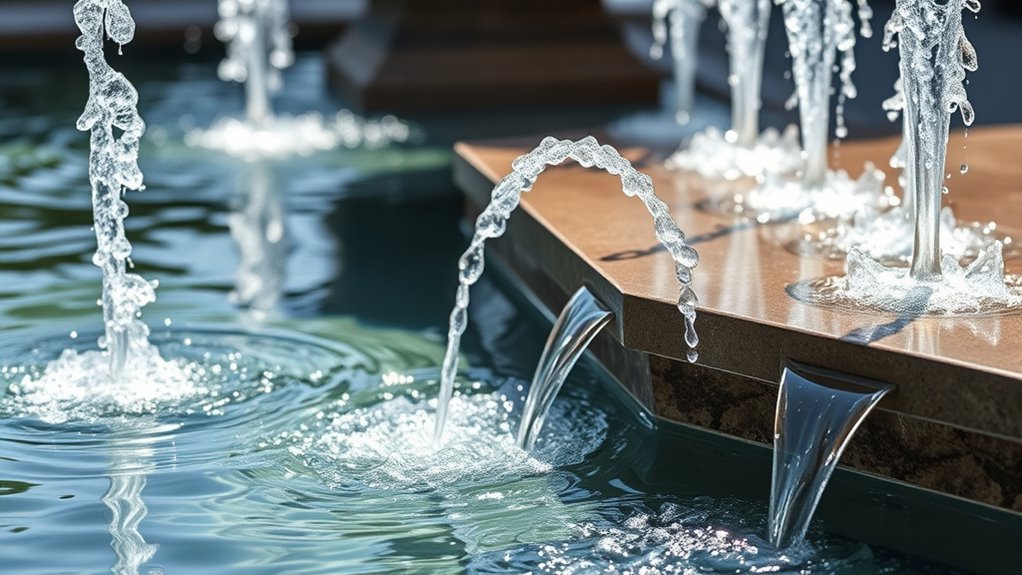
Designing water features that enhance aesthetic appeal without excessive energy use requires careful planning. You should select features that naturally fit the space and consider scale to avoid overuse of resources. Opt for designs that maximize visual impact with minimal movement, such as laminar streams or subtle deck jets, which can create striking effects while conserving energy. Incorporate automation controls, like timers and sensors, to run features only when needed. Choose energy-efficient pumps and lighting to reduce consumption further. Prioritize materials and placements that minimize evaporation and heat loss. Implementing water quality measures can also help maintain clarity and reduce maintenance costs over time. By balancing creative vision with practical considerations, you ensure your water feature remains beautiful and sustainable, avoiding unnecessary waste and aligning with conservation goals. This thoughtful approach helps you achieve both aesthetic excellence and environmental responsibility.
Maintenance and Operational Costs Over Time
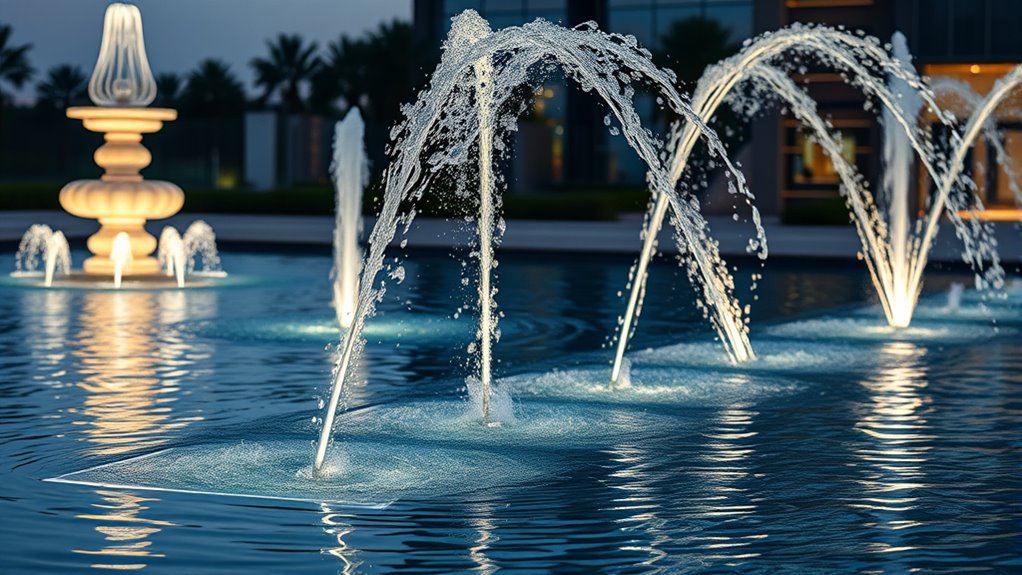
As you operate bubblers, deck jets, and laminar streams, you’ll need to contemplate ongoing energy costs that add up over time. Regular cleaning and maintenance can also impact your budget, especially as parts wear out or need replacement. Understanding these expenses helps you plan effectively and avoid surprises down the road. Additionally, choosing performance modifications like upgraded pumps or controllers can influence both energy consumption and maintenance requirements.
Long-term Energy Expenses
Long-term energy expenses for bubblers, deck jets, and laminar streams can considerably influence your overall maintenance and operational costs. These features require consistent power to operate, especially if they run continuously or frequently. Deck jets and laminar streams often use pumps and heating elements, which consume significant electricity over time. While initial installation costs may be manageable, ongoing energy bills can add up, affecting your budget. Efficient equipment, such as variable-speed pumps and LED lighting, can reduce energy use and save money long-term. Regularly monitoring energy consumption helps identify inefficiencies. Remember, the more complex and powerful your water features are, the higher your energy expenses will be, so balancing aesthetic appeal with energy efficiency is key to controlling costs over the years.
Cleaning and Upkeep Costs
Regular cleaning and maintenance are essential to keep bubblers, deck jets, and laminar streams functioning properly and looking their best. Over time, mineral buildup, algae, and debris can clog nozzles and reduce flow efficiency, increasing your maintenance efforts. You’ll need to regularly inspect and clean filters, nozzles, and surrounding surfaces to prevent blockages and damage. Pump and motor upkeep also plays a role, requiring periodic lubrication and checks for leaks or wear. Chemical treatments or water conditioners might be necessary to control algae and mineral deposits, adding to ongoing costs. Neglecting maintenance can lead to costly repairs or replacements down the line. Staying proactive with routine cleaning and inspections helps ensure your water features operate smoothly, preserve their aesthetic appeal, and avoid unexpected expenses. Additionally, implementing proper filtration systems can significantly reduce the frequency of cleaning and extend the lifespan of your water features.
Replacement Frequency and Budget
Replacing bubblers, deck jets, and laminar streams depends on how often they experience wear or clogging, which varies based on usage and water quality. Regularly, you might need to replace components every 1-3 years. Budget considerations include initial purchase costs, installation fees, and ongoing maintenance. High-quality fixtures tend to last longer but cost more upfront. Keep in mind that frequent clogging or damage increases replacement frequency and expenses. Planning for these costs helps you avoid surprise expenses. Staying proactive with maintenance can extend equipment lifespan. Proper installation techniques ensure optimal performance and longevity. Here’s what to contemplate:
- Initial purchase price
- Installation costs
- Replacement parts
- Frequency of clogging or wear
- Long-term operational costs
Making Informed Choices for Sustainable Water Features
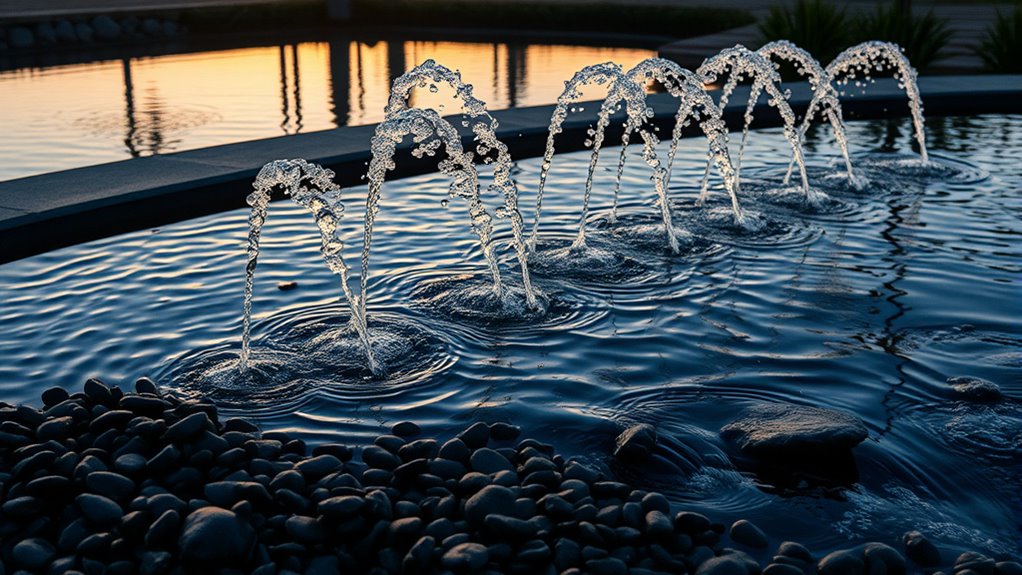
Choosing sustainable water features involves understanding their environmental impact and energy efficiency. To make informed choices, consider options that minimize water and energy use while maintaining aesthetic appeal. Look for features with efficient pumps, recirculating systems, and low water consumption. Avoid designs that require constant refilling or excessive filtration. Research products with eco-friendly certifications and durable materials. Incorporating regular assessments of water features ensures ongoing efficiency and sustainability.
Frequently Asked Questions
How Do Climate Conditions Influence Evaporation Rates of These Features?
Climate conditions markedly impact evaporation rates of these features. When it’s hot, dry, and windy, you’ll notice faster evaporation because heat and air movement increase water loss. Conversely, cooler, humid, and calm conditions slow down evaporation. You can manage this by adjusting water flow or using covers during high evaporation periods. Monitoring weather helps you optimize water features, reducing unnecessary water loss and maintaining their aesthetic appeal.
Are There Eco-Friendly Materials Suitable for Constructing Water Features?
Sure, you can build eco-friendly water features using recycled glass, bamboo, and biodegradable plastics—because nothing screams “sustainable” like a fountain that’s guilt-free. Think about materials that resist algae naturally and require minimal chemical treatments. You’ll love how these choices reduce environmental impact while still dazzling your yard. So go ahead, splash some eco-chic style, and let Mother Nature thank you with a more sustainable splash.
Can Water Features Be Integrated With Rainwater Harvesting Systems?
Yes, you can definitely integrate water features with rainwater harvesting systems. By connecting your feature to a rainwater tank, you guarantee sustainable water use and reduce reliance on municipal supplies. You’ll need a filtration system to keep the water clean and a pump to circulate it effectively. This setup promotes eco-friendliness, conserves potable water, and creates a beautiful, sustainable addition to your landscape.
What Are the Health and Safety Considerations for Public Installations?
You must prioritize safety by installing secure barriers and clear signage to prevent accidents around water features. Regular maintenance is essential to avoid slips, falls, and waterborne illnesses. Make certain of adequate filtration and sanitation to keep the water clean and safe. You also need to take into account electrical safety and proper drainage. Balancing aesthetic appeal with safety measures creates a visually stunning yet secure environment for all visitors.
How Do Local Regulations Impact the Installation of Water Features?
You need to check local regulations before installing water features, as they often specify safety standards, water quality, and environmental impact. Regulations may require permits, inspections, or specific safety measures like fencing or signage. Ignoring these rules can lead to fines, delays, or safety hazards. By understanding and adhering to local laws, you ensure your installation is legal, safe, and environmentally responsible, avoiding costly issues down the line.
Conclusion
When choosing water features, remember that laminar streams often create stunning visual effects, but they can evaporate up to 70% more water than bubblers or deck jets. Balancing beauty with conservation means considering both aesthetics and efficiency. By making informed choices, you can enjoy mesmerizing displays while reducing water waste and energy costs—helping you create sustainable, eye-catching environments that won’t drain resources. Ultimately, thoughtful design ensures your water features impress without unnecessary environmental impact.
